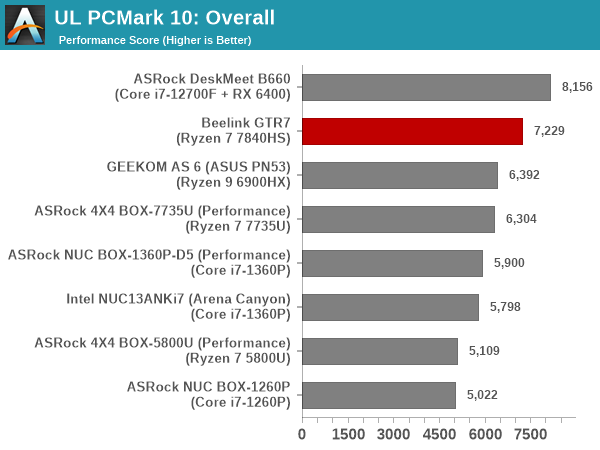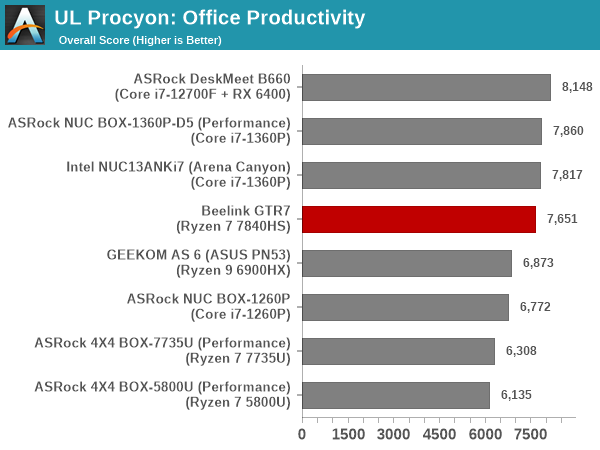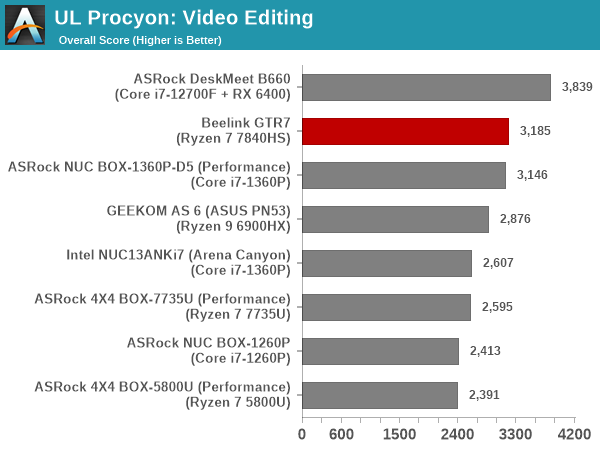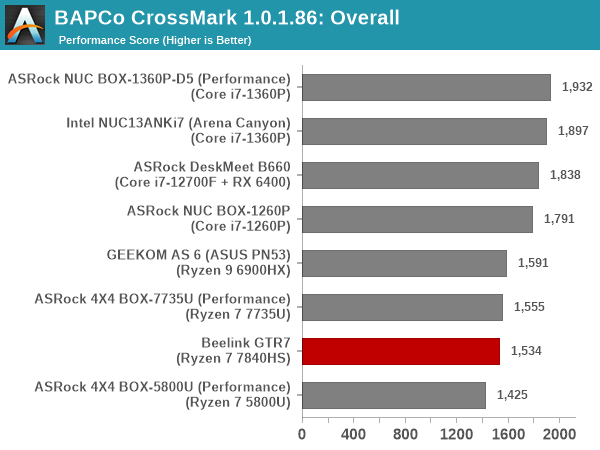Beelink GTR7 mini-PC Review: A Complete AMD Phoenix Package at 65W
by Ganesh T S on August 24, 2023 8:00 AM ESTSystem Performance: UL and BAPCo Benchmarks
Our 2022 Q4 update to the test suite for Windows 11-based systems carries over some of the standard benchmarks we have been using over the last several years. While UL's PCMark makes the list, we have opted to temporarily suspend reporting of BAPCo's SYSmark scores (pending fixture of the energy consumption aspect). Instead, BAPCO's CrossMark multi-platform benchmarking tool has been added to the set along with UL's Procyon suite. While CrossMark employs idle time compression and processes all workloads in an opaque manner, UL's Procyon processes real-world workloads with user interactions (like BAPCo's SYSmark). We have augmented the UL Procyon suite benchmark with our own custom energy measurement setup.
UL PCMark 10
UL's PCMark 10 evaluates computing systems for various usage scenarios (generic / essential tasks such as web browsing and starting up applications, productivity tasks such as editing spreadsheets and documents, gaming, and digital content creation). We benchmarked select PCs with the PCMark 10 Extended profile and recorded the scores for various scenarios. These scores are heavily influenced by the CPU and GPU in the system, though the RAM and storage device also play a part. The power plan was set to Balanced for all the PCs while processing the PCMark 10 benchmark. The scores for each contributing component / use-case environment are also graphed below.
| UL PCMark 10 - Performance Scores | |||

Discounting the DeskMeet B660, the GTR7 outscores the competition on the back of its lead in the productivity, gaming, and digital content creation workloads. The Essentials workload sees the Arena Canyon NUC enjoy a slight edge, but the sustained 65W configuration of the Ryzen 7 7840HS possesses way too much horsepower for the rest of the systems to match.
UL Procyon v2.1.544
PCMark 10 utilizes open-source software such as Libre Office and GIMP to evaluate system performance. However, many of their professional benchmark customers have been requesting evaluation with commonly-used commercial software such as Microsoft Office and Adobe applications. In order to serve their needs, UL introduced the Procyon benchmark in late 2020. There are five benchmark categories currently - Office Productivity, AI Inference, Battery Life, Photo Editing, and Video Editing. AI Inference benchmarks are available only for Android devices, while the battery life benchmark is applicable to Windows devices such as notebooks and tablets. We presents results from our processing of the other three benchmarks.
| UL Procyon - Office Productivity Scores | |||

The GTR7 manages a narrow victory in the Powerpoint workload, but the NUCs based on the Core i7-1360P emerge with slightly better overall scores.

From an energy consumption viewpoint, the 4nm fabrication process for the Ryzen 7840HS seems to help the GTR7. While raw performance scores see it slightly behind the Raptor Lake-based systems, the absolute values are fairly similar. However, the GTR7 gets the job done with minimal power consumption, and as a result, lesser overall energy consumption.
Moving on to the evaluation of Adobe Photoshop and Adobe Lightroom, we find the GTR7 coming out with a slightly better score compared to the systems using the Core i7-1360P. The flow utilizes some of the iGPU functionality, and the improvements in the Radeon 780M show up here along with the higher sustained power budget. Interestingly, the photo editing workload was the one that refused to complete with GPU drivers supplied initially by Beelink, but AMD's first public driver release for Phoenix resolved the issue.

The energy efficiency of the Phoenix SoC again comes to fore here, with the GTR7 being the most energy efficient by a huge margin.

UL Procyon evaluates performance for video editing using Adobe Premier Pro.

The GTR7 emerges as the best system among those not equipped with a discrete GPU. Its performance is within the realms of run-to-run variations with the souped up Core i7-1360P in ASRock Industrial's NUC BOX-1360P/D5.

On the energy front, the ability to get the job done fast helps in placing the GTR7 in the top half of the pack. The system comes second, falling slightly behind the ASRock Industrial NUC BOX-1360P/D5 with its CPU operating mode set to 'Performance' in the BIOS. However, similar to the raw performance scores, the gap is quite small.
BAPCo CrossMark 1.0.1.86
BAPCo's CrossMark aims to simplify benchmark processing while still delivering scores that roughly tally with SYSmark. The main advantage is the cross-platform nature of the tool - allowing it to be run on smartphones and tablets as well.
| BAPCo CrossMark 1.0.1.86 - Sub-Category Scores | |||

The use of idle time compression favors Intel-based systems, but that is not indicative of real-world performance. Based on these results, it would appear that scripting and automating workloads to keep the system busy all the time would probably be better on the Intel-based PCs. It is also possible that there could be BIOS tweaks and further tuning from Beelink to help the GTR7 perform better under such circumstances. Since CrossMark attempts to consolidate different workloads together without idle time intervals and play it back in a non-real-time environment, it is not entirely representative of real-world performance like PCMark 10 and UL Procyon. Therefore, tasks requiring frequent user interaction are better represented by those other benchmarks.










56 Comments
View All Comments
ganeshts - Friday, August 25, 2023 - link
The fan shown in the photo is for the RAM and the SSD (please take a look at the picture in the thermal characteristics section for more context on where that fan goes in the overall system).The fan behind the heat spreaders connected to the vapor chamber is not pictured in the article, but available in the cross-sectional view on Beelink's product page:
https://img.bee-link.com/media/upload/5/o2/5o29ppo...
It is a typical notebook fan, and combined with the vapor chamber, it is effective enough to handle the 65W cTDP setting.
abufrejoval - Friday, August 25, 2023 - link
"pro" vs. "non-pro" in APU or Ryzen G parlance used to indicate support for ECC RAM, which for some reason was *not* included for the APUs vs the "normal" Ryzens.So my question here is: does the Pro variant (with a Ryzen 7 7845) support ECC RAM?
Because that's pretty much the only remaining item on my wish lilst for this class of machine (well, I'd rather have them as Mini-ITX, but that doesn't seem to happen).
abufrejoval - Monday, August 28, 2023 - link
Just in case somebody else wonders: Pro vs. non-Pro evidently is no longer a differentitator for ECC support on the Phoenix series APUs. It's all in the "socket" or rather package; FP7 and FP8 do not support ECC while FP7r2 *can*, if the platform does, independent of the particular chips (Ryzen 3 vs 9) or the "Pro": each chip is available in each "socket" or form factor...And to muddy the waters even further, you can't tell the "socket" from the branding/model, I supposed there is a part number that will tell you but for a device like this, you'd mostly have to hope that the vendor will tell you.... fat chance, I'd say from past experience.
And looking at the *5 parts, I noticed that for Phoenix this is used to indicated the desktop die derived high-TDP mobile parts using the FL1 "socket": while the desktop chips generally support ECC, these mobile workstation parts absolutely do not, most likely because the FL1 "socket" otherwise would have required a couple of extra traces...
Sometimes I'd like to have a word with AMD's cost cutters, beause they keep cutting into vital flesh and kill entire market niches with their excess.
abufrejoval - Monday, August 28, 2023 - link
Digging further (sorry), the availability of DDR5 sockets seems to indicate FP7r2: FP7 and FP8 seem to be exclusively (soldered) LPDDR5.There are SO-DIMM 32GB, DDR5-4800, CL40-39-39, ECC, on-die ECC modules available from Kingston which are listed as dual-rank x8, while AMD lists "4x2R" support...
Ganesh if you happen to have some ECC DDR5 SO-DIMMs available I'd be really thankful for a test!
And the Dragon Range (desktop derived) FL1 "socket" parts definitely do not support LPDDR5,only (SO-)DIMMs but still no ECC....
jepo - Friday, August 25, 2023 - link
I bought one of these with the 7940HS via Aliexpress (679 gbp) in July after the review in ServeTheHome. It arrived in 2 weeks, same spec as this review except the 7940HS and mine is grey. I added an extra 2Tb Samsung 990 Pro SSD. To my surprise on first boot it has Windows 11 Pro installed. I gave it a CPU bound process to do that I expected to take 2 weeks given that is how long it would take on my 4 year old 3900X 12 core desktop. It completed in 10 days. During that time it was 100% CPU all cores. Yes the fan is quite noisy, but there was no throttling. In my opinion it's a great little box, and I've changed to use this as my main dev machne.shiromar - Monday, August 28, 2023 - link
I am consider something small and powerful for gen 7 game emulation. can this beelink handle the gen7 stuff?Also i would really like to install steamOS via holoiso. Does anyone know if this GPU plays nice with holo?
thanks